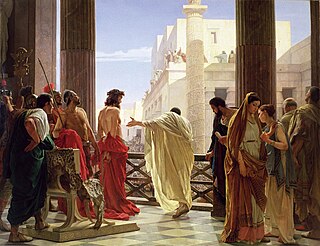
Pontius Pilate was the fifth governor of the Roman province of Judaea, serving under Emperor Tiberius from the year 26/27 to 36/37 AD. He is best known today for being the official who presided over the trial of Jesus and later ordered his crucifixion. Pilate's importance in modern Christianity is underscored by his prominent place in both the Apostles' and Nicene Creeds. Due to the Gospels' portrayal of Pilate as reluctant to execute Jesus, the Ethiopian Church believes that Pilate became a Christian and venerates him as a martyr and saint.

Il Sodoma was the name given to the Italian Renaissance painter Giovanni Antonio Bazzi. Il Sodoma painted in a manner that superimposed the High Renaissance style of early 16th-century Rome onto the traditions of the provincial Sienese school; he spent the bulk of his professional life in Siena, with two periods in Rome.
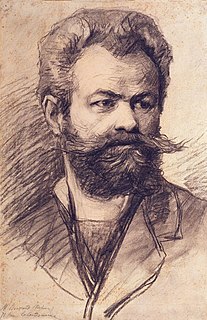
Mihály Munkácsy was a Hungarian painter. He earned international reputation with his genre pictures and large-scale biblical paintings.

Ecce homo are the Latin words used by Pontius Pilate in the Vulgate translation of the Gospel of John, when he presents a scourged Jesus Christ, bound and crowned with thorns, to a hostile crowd shortly before his Crucifixion. The original New Testament Greek: "ἰδοὺ ὁ ἄνθρωπος", romanized: "idoú ho ánthropos", is rendered by most English Bible translations, e.g. Douay-Rheims Bible and King James Version, as "behold the man". The scene has been widely depicted in Christian art.
"Ecce homo", is a phrase uttered by Pontius Pilate at the trial of Christ.

Ecce Homo is a painting by the Italian Baroque master Caravaggio. It is housed in the Palazzo Bianco, Genoa. Contemporary accounts claim the piece was part of a unannounced competition between three artists, and that the Caravaggio version was eventually sent to Spain.

Ecce Homo is a painting of the episode in the Passion of Jesus by the Early Netherlandish painter Hieronymus Bosch, painted between 1475 – 1485. The original version, with a provenance in collections in Ghent, is in the Städel Museum in Frankfurt; a copy is held the Museum of Fine Arts in Boston. The painting takes its title from the Latin words Ecce Homo, "Behold the Man" spoken by the Roman Prefect Pontius Pilate when Jesus is paraded before a baying, angry mob in Jerusalem before he is sentenced to be crucified.
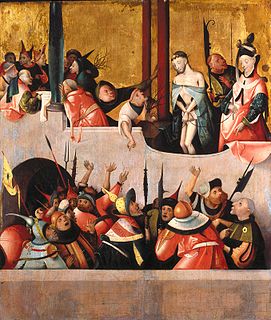
Ecce Homo is a painting by a follower of the Netherlandish painter Hieronymus Bosch. It depicts the presentation of Jesus Christ by Pontius Pilate to the throngs of Jerusalem. This painting is at the Indianapolis Museum of Art in Indianapolis, Indiana; it is closely similar to one at the Philadelphia Museum of Art.

The Flagellation of Christ, sometimes known as Christ at the Column or the Scourging at the Pillar, is a scene from the Passion of Christ very frequently shown in Christian art, in cycles of the Passion or the larger subject of the Life of Christ. It is the fourth station of the modern alternate Stations of the Cross, and a Sorrowful Mystery of the Rosary. The column to which Christ is normally tied, and the rope, scourge, whip or birch are elements in the Arma Christi. The Basilica di Santa Prassede in Rome claims to possess the original column.
Ecce is the Latin word meaning behold. It occurs in the following phrases:
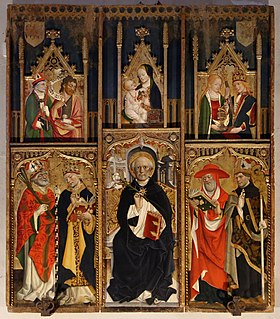
Giovanni Canavesio (before1450–1500) was an Italian artist, documented as a "master artist" in 1450. He was proficient in polyptychs or panels, monumental paintings, and book illuminations. He was active in Liguria and southern France later in his life but documents of his activities before 1450 are missing.

Scenes from the Passion of Christ is an oil painting on a panel of Baltic oak, painted c.1470 by German-born Early Netherlandish painter Hans Memling. The painting shows 23 vignettes of the Life of Christ combined in one narrative composition without a central dominating scene: 19 episodes from the Passion of Christ, the Resurrection, and 3 later appearances of the risen Christ. The painting was commissioned by Tommaso Portinari, an Italian banker based in Bruges, who is depicted in a donor portrait kneeling and praying in the lower left corner, with his wife, Maria Baroncelli, in a similar attitude in the lower right corner.

The Grey Passion is a series of paintings by Hans Holbein the Elder (1465-1524). Executed between 1494 and 1500, it comprises twelve panels illustrating the Passion of Christ; Holbein's monochrome palette is almost entirely grey. The paintings were purchased by the Staatsgalerie Stuttgart, the Stuttgart State Art Gallery in Germany. The State Art Gallery acquired the altarpiece in 2003 for 12 million euros. The restoration of the artworks lasted three years and cost 450 thousand euros.

The Calvary at Pleyben, dating from 1555, is located in the village of Pleyben in Brittany, northwestern France.
The Calvary at Saint-Thégonnec is part of the enclosure of the parish church of Notre-Dame in Saint-Thégonnec. Erected in 1610 it is the last of the monumental calvaries of Brittany. See also Saint-Thégonnec Parish close.

The Plourin-lès-Morlaix Parish close is located at Plourin-lès-Morlaix in the arrondissement of Morlaix in Brittany in north-western France. The Enclos paroissial comprises the Notre-Dame church, a cemetery, ossuary and retaining wall. The church is a listed historical monument since 1932.

Ecce Homo is a statue of the Christian figure, Jesus of Nazareth, during his trial after being imprisoned by the Romans. The statue's title, Ecce Homo, is an allusion to the famous proclamation by Pontius Pilate, "Behold the Man." The statue, made entirely of carved wood, depicts Jesus in a horrific state of suffering and anguish. Although its creator remains anonymous, Ecce Homo is believed to have been carved in Spain sometime around the year 1600 AD. Like many forms of Baroque era art, the focus of this piece comes in the form of an emotional connection with Christ. In the Summer 2010 issue of the Loyola University Magazine, Jonathan Canning explains the artistic technique used by the creator to convey this emotion, "His [Christ’s] skin has been painted to reveal bruising and welts beneath the skin, while small, red glass beads have been set into the sculpture’s open wounds to suggest flowing blood." Additionally, Christ's face has been carved so that he is looking down, with an expression that depict complete misery. It is believed that the artist's aim was to trigger a sympathetic response with the viewer. The pathos attributed to this piece may have been intended to serve as a form of worship in which Christians create an emotional connection with Christ.
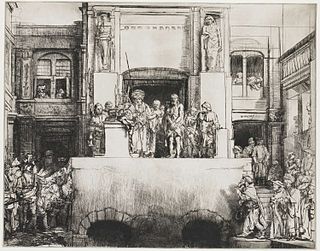
Christ Presented to the People, also known as Ostentatio Christi or Ecce Homo, is a drypoint print by Rembrandt van Rijn which exists in eight states, all c.1655. It is one of the two largest prints made by Rembrandt, about 15 by 18 inches, similar to his 1653 engraving of The Three Crosses. It has been described by Christie's as "at the summit of the western printmaking tradition".

Ecce Homo is an unfinished painting produced in 1850 by the French painter and caricaturist Honoré Daumier which is in the collection of the Museum Folkwang in Essen, Germany.

The Holy Family with Saint John the Baptist and an Angel is a religious painting by the Italian Renaissance artist Giovanni Antonio Bazzi aka Il Sodoma, dated to c. 1535–1540. It is now in the Musée des Beaux-Arts of Strasbourg, France. Its inventory number is 351.
















